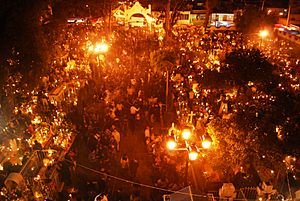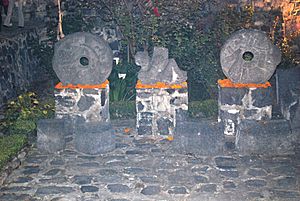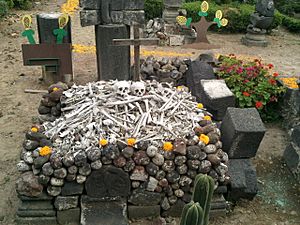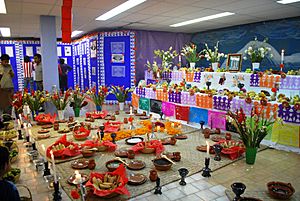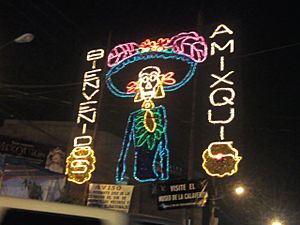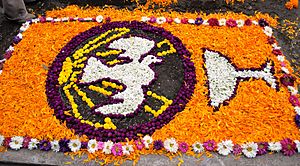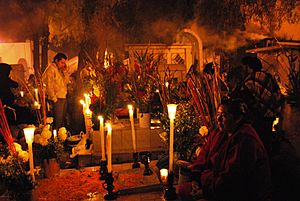San Andrés Mixquic facts for kids
San Andres Míxquic is a special community located in the southeast part of Mexico City. It's in an area called Tláhuac. This community was started around the 11th century on what used to be a small island in Lake Chalco. The name “Míxquic” means “in mesquite trees.” For most of its history, the people here used a farming method called chinampas. These were like floating gardens on the lake, tied to the island.
Over time, in the 1800s and 1900s, Lake Chalco was drained. This sadly destroyed the chinampas. But Míxquic is still a farming community today, even though it's officially part of Mexico City.
San Andres Míxquic is most famous for its Day of the Dead celebrations. These events include special traditions and cultural activities. They happen from October 31 to November 2. Thousands of visitors from Mexico and other countries come to see them. The celebrations end with something called the Alumbrada. On the evening of November 2, the cemetery around the main church lights up. It glows with thousands of candles and smoke from incense. In 2011, Mexico City named Míxquic a "Barrio Mágico" (Magical Neighborhood).
Contents
History of Míxquic
The community of Míxquic probably began around the 11th century. People moved here from Xochimilco. A long time ago, before the Spanish arrived, Míxquic was a small island in Lake Chalco. The people built chinampas, which were like floating farms, around the island.
At first, Míxquic was independent. But because it had such good farming land, other powerful groups took control of it. These included Xochimilco, Chalco, Azcapotzalco, and finally Tenochtitlan. A writer named Bernal Diaz del Castillo described Míxquic. He said it was full of white towers and temples. The Spanish first called it “Venezuela” because it looked like Venice.
Hernán Cortés took control of this area on May 20, 1521. After that, soldiers from Míxquic helped him conquer Tenochtitlan. They had not been friendly with Tenochtitlan before.
Míxquic in Colonial Times
During the time of Spanish rule, this area was first directly controlled by the Spanish Crown. Later, it became an encomienda, which meant a Spanish person was in charge of the land and people. This lasted until the 1600s.
Between 1536 and 1563, a monastery called San Andres Apostol was built here. Friars Jorge de Avila and Geronimo de San Esteban built it. Míxquic then became the main religious center for the nearby areas.
In 1833, four crosses were placed in different neighborhoods. These marked the original size of the main church's courtyard and cemetery. This area was changed by 1860. This was partly to build the Cristóbal Colon Primary School and the Andrés Quintana Roo Library.
In the late 1800s and early 1900s, Lake Chalco was drained. This big project was finished during the time of Porfirio Diaz.
Míxquic Joins Mexico City
The village of Míxquic became part of the Mexico City area in 1898. This had big effects, as city leaders then controlled Míxquic’s resources, especially its water. In 1916, during the Mexican Revolution, soldiers took over the monastery.
In the early 1900s, the community kept many of its chinampas. They used water from wells. But by the 1960s, this was no longer possible. This ended the community's lake-based way of life. However, farming is still very important here. Míxquic grows many vegetables for Mexico City. The community is about three square kilometers, and most of it is used for farming. More than half of this land is ejido, which is community-owned land. Most of the vegetables are sold at a huge food market in the city.
Life is changing in Míxquic as it becomes more connected to Mexico City. There are more cars and public buses. This means more young people from Míxquic are finding jobs in the city or going to university.
Exploring the Village
The heart of the village is the church and old monastery of San Andres Apostol. This monastery was built between 1536 and 1563. It was built by friars Jorge de Avila and Geronimo de San Esteban. The church and monastery were built on top of an ancient teocalli, which was a sacred place in Míxquic.
The first church was taken down, but its original bell tower is still there. The church you see today was built in 1600. It has three main parts called naves and a round roof called a cupola. But it is separate from the old bell tower. The walls of the old monastery are very thick, about 90 centimeters. They are made of a stone called tezontle. In 1932, the church and monastery were named a historic monument.
Ancient Discoveries
In the courtyard of the old monastery, you can see some ancient artifacts. One is a sculpture of Miquiztli or Mixquixtli. This was the goddess of life and death. Another important find is a Chac Mool statue. It is displayed between two rings from an old Mesoamerican ballcourt. There are also columns with figures of Quetzalcoatl and skulls carved from volcanic stone.
The Andres Quintana Roo Library is also the town's museum. This museum has many ancient items on display. Most of these pieces are from the old teocalli and other areas around Míxquic. A local woman named Socorro Bernal Roque donated the collection. Most of the items are made of clay and stone. They are mostly from the late post-classic period (1200–1500). But some pieces are from the Toltec and Teotihuacan cultures.
Some special items include a chac mool statue and parts of an ancient ballcourt. There are also clay and stone stamps, a coiled snake, and other snake figures. You can also see a tzompantli (skull rack) and a calendar stone. This calendar was hollowed out to become a baptismal font.
A small area with canals and chinampas still exists near the town.
Some leaders in Mexico City want Míxquic to become a World Heritage Site. They believe the area is special because of its unique environment. It is important for migrating birds and helps refill local underground water sources called aquifers. Making the church cemetery and ancient sites a World Heritage Site would help protect them. It would also help share their cultural importance.
Day of the Dead Celebrations
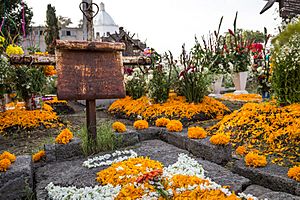
Day of the Dead is the most important celebration in Míxquic. It includes two days of special traditions and cultural events. These happen on November 1 and 2. The village and its church graveyard are very famous in Mexico City for these celebrations.
Around the cemetery, thousands of visitors come to experience the sights, sounds, and smells. There are rituals, cultural events, and stands selling food, crafts, and other things. These modern celebrations continue a tradition of honoring the dead that has been here since ancient times. Digging in this area has found many stone skulls. These used to decorate the fronts of homes.
In Míxquic, serious remembrance and fun celebrations happen together. Both are part of the event. Besides the traditional altars for the dead, called “ofrendas,” people clean and decorate graves. There are also plays, parades, poetry readings, concerts, and folk dances. In 2009, a singer named Susana Harp performed at the end of the event.
People start getting ready for this celebration two or three months early. Families buy special plates and utensils just for the ofrendas. Women sew napkins and tablecloths for the occasion. In mid-October, people hang a large paper star lantern over their doors. It stays there until November 3. This star helps guide the spirits of the dead who come back to visit.
In the days before Day of the Dead, fields around the community bloom with cempoalxóchitl flowers. You can smell their fragrance in the air. Other smells, like seasonal fruits and pan de muerto (bread of the dead), also fill the air. People say, “ya huele a muertos” (now it smells like the dead) or “ya se siente muertitos” (now the dear dead can be felt). This means Day of the Dead is coming soon.
In primary schools, students and teachers make Day of the Dead altars, called ofrendas. Teachers make a big altar for the school. Students create smaller ones, sometimes with themes. These are shown to the public. The altars at Cristobal Colon Primary School are visited the most. This is because the school is close to the church. Days before the celebrations, people start cleaning and fixing tombs.
The Ofrendas and Visits
The final preparations happen on October 30. Families set up their ofrendas in their homes. Each family has its own way of doing it. But some things are common. They offer bread, flowers, candles, water, salt, incense, and photographs. The traditions mix ancient customs with Catholic rites. Adding photographs is a modern touch. Most of these offerings are made privately at home altars. But you can also see some elements at the cemetery on the graves.
A special local food is a donut-shaped bread with a dark pink glaze. It's called “roscas rosas.” These are placed with pan de muertos. People open their doors to invite the dead to visit.
From October 31 to November 2, friends and family visit the ofrendas. They bring items for the altars. These are usually things the person who passed away liked when they were alive. As visitors come, the ofrenda grows. The hosts offer food and drinks to their visitors.
At midnight on October 31, the church bells ring. This signals the arrival of the souls of children who have passed away. Ofrendas for children often have bright toys. One traditional toy is a dog named Izcuincle. This comes from the Nahuatl word for dog. It is believed to guide children over a river called Chiconauhuapan to enter Mictlán (the land of the dead). On this day, no offerings should be left for adults. People believe the children get angry and sad if this happens.
On the morning of November 1, a breakfast is placed on the children's ofrenda. A trail of white flowers called “alhelí” leads from outside to this altar. These flowers symbolize the pureness of children's souls. The souls of children visit from midnight on October 31 until midday on November 1. At this time, when “the sun passes its highest point,” local people believe the “souls of the children return to Mictlán.” Then, the souls of adults arrive and stay through November 2.
Night of November 1
When night falls on November 1, the air fills with music. You can hear tropical and mariachi groups. There is also a contest for skulls made from cardboard. These are painted and have funny sayings or jokes written on them.
A pretend funeral procession comes through the village. A supposed widow shouts funny phrases to the crowd about losing her husband. He is carried in a coffin. The procession moves toward the graveyard. Helpers ask for money for the “burial” and make jokes. When they get to the graveyard, the "husband" jumps out of the coffin! He runs off scared into the crowd, making everyone laugh.
At seven in the evening on November 1, the church bells ring again. This starts the Hour of Campanera. Groups of young people walk from house to house carrying bells. They sing a song: "a las ánimas benditas les prendemos sus ceritas. Campanero, mi tamal" (to the blessed souls we light our candles. Campanero, my tamale). After singing, they receive tamales, candy, or fruit.
On the morning of November 2, people seriously begin cleaning and decorating graves. Graves in the main cemetery, which surrounds the Church of San Andres Apostol, are decorated. They use flowers, especially cempasúchil, candles, and other items. The tombs are decorated carefully and sometimes beautifully. People make images of the Virgin, crosses, or other symbols with flowers, petals, or colored sawdust.
These graves are prepared for the Alumbrada. This begins at eight in the evening when the church bells ring again. By this time, the church has its own large ofrenda. Its lights are dimmed. At this hour, the cemetery around the church is full of color from the flowers. It glows from the light of thousands of burning candles. Thick smoke from copal incense fills the air.
Because so many visitors come, special security was put in place in 2009. Many police officers, on foot and on horseback, patrolled. Extra equipment helped control traffic. Selling alcohol was limited to certain areas and times.
See also
 In Spanish: San Andrés Míxquic para niños
In Spanish: San Andrés Míxquic para niños


